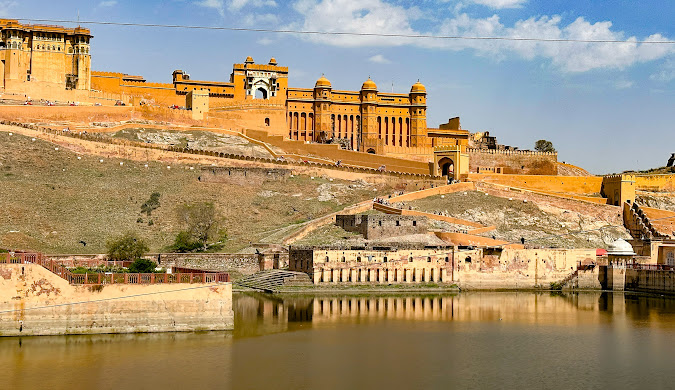Jaipur
Summary of Jaipur
Jaipur, the capital city of Rajasthan, is famously known as the "Pink City" due to the distinctive color of its buildings. Founded in 1727 by Maharaja Sawai Jai Singh II, Jaipur is renowned for its rich cultural heritage, magnificent architecture, and vibrant traditions. The city seamlessly blends its royal past with a modern lifestyle, offering visitors a unique experience. With its historic forts, palaces, temples, and bustling markets, Jaipur is a key destination in the Golden Triangle tourist circuit, which includes Delhi and Agra.
Tourist Points in Jaipur
- Amber Fort and Palace
- Located 11 kilometers from Jaipur, Amber Fort is a majestic fort known for its artistic Hindu style elements. The fort overlooks Maota Lake and is famous for its large ramparts, series of gates, and cobbled paths. Inside the fort, visitors can explore the Diwan-i-Aam, Diwan-i-Khas, Sheesh Mahal, and Sukh Niwas.
- City Palace
- Situated in the heart of Jaipur, the City Palace complex is a blend of Mughal and Rajasthani architecture. It includes the Chandra Mahal and Mubarak Mahal palaces and other buildings. The Chandra Mahal now houses a museum, but the greatest part of it is still a royal residence.
- Hawa Mahal
- Known as the "Palace of Winds," Hawa Mahal is an iconic landmark of Jaipur. This five-story pyramidal structure is made up of 953 small windows, called jharokhas, decorated with intricate latticework. It was built so that royal women could observe street festivals while remaining unseen from the outside.
- Jantar Mantar
- A UNESCO World Heritage site, Jantar Mantar is an astronomical observatory built by Maharaja Sawai Jai Singh II. It houses the world’s largest stone sundial and various other instruments used to measure time, predict eclipses, and track stars.
- Nahargarh Fort
- Perched on the Aravalli hills, Nahargarh Fort offers a panoramic view of Jaipur city. Originally built as a retreat by Maharaja Sawai Jai Singh II, it has witnessed several historical events and battles. The fort is especially beautiful at sunset.
- Jal Mahal
- The "Water Palace" is situated in the middle of Man Sagar Lake. This five-story palace, of which four floors remain submerged when the lake is full, combines Mughal and Rajput styles of architecture. Although entry inside the palace is restricted, the view from the lake is breathtaking.
- Albert Hall Museum
- The oldest museum in Rajasthan, Albert Hall Museum is located in Ram Niwas Garden. It showcases a rich collection of artifacts, including paintings, carpets, ivory, stone, metal sculptures, and works in crystal.
- Birla Mandir
- Also known as Laxmi Narayan Temple, Birla Mandir is dedicated to Lord Vishnu and Goddess Laxmi. Built entirely of white marble, the temple is adorned with intricate carvings and paintings depicting mythological events.
- Jaipur Markets
- Jaipur is famous for its vibrant markets. Johari Bazaar is known for its jewelry, Tripolia Bazaar for its lac jewelry and bangles, Chandpole Bazaar for marble sculptures, and Bapu Bazaar for textiles and handicrafts. These markets offer a true taste of Jaipur's vibrant culture and craftsmanship.
- Chokhi Dhani
- An ethnic village resort, Chokhi Dhani provides a glimpse of Rajasthan’s traditional culture and lifestyle. Visitors can enjoy traditional Rajasthani cuisine, folk dances, music, camel rides, and other cultural activities in a recreated village setting.
Jaipur's blend of historical significance, architectural marvels, and cultural richness makes it a must-visit destination for travelers exploring Rajasthan.



